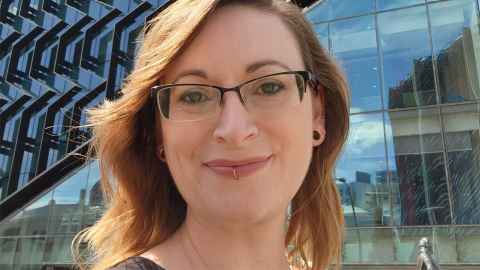Take 10 with... Kate Storrs
Kate Storrs, senior lecturer in the School of Psychology, gives us 10 minutes of her time to discuss her research into computational visual neuroscience, opportunities she has had throughout her career, and her advice for early-career researchers.

1. Describe your research topic to us in 10 words or less.
Computational visual neuroscience, focusing on mid-level vision.
2. Now explain it in everyday terms!
I’m interested in how we make sense of the visual world. If someone takes you into a room blindfolded and then removes the blindfold, within a few hundred milliseconds you’ll have a super detailed understanding of the layout of that room: how big it is, where the light is coming from, which parts of the room you could walk across, where there are obstacles, what objects you could pick up, what those objects are made of, and so on. To achieve this, about one-third of our brain is involved in processing the light that hits our eyes. I’m interested in how the brain does this and in developing a computer-based model that works in a similar way.
3. Describe some of your day-to-day research activities.
Despite having a psychology background, most of my research activities involve computer programming. I use game engines like Unity3D to create images and videos to use in my experiments. Then I build interactive experiments using software called PsychoPy to show people images, ask them questions, and record their responses. I then spend a lot of time writing Python code to train and test AI computer vision models. Finally, I use Python to analyse my data and compare the responses of humans and AIs to images. A lot of research is also planning projects, having meetings, doing admin, or reading and writing papers, so actually running experiments and analysing data is a minority of my time.
4. What do you enjoy most about your research?
I’ve always been fascinated by vision. Before I went into research I studied at a Film and TV school and wanted to be a cinematographer, and I still paint and draw. I find it both scientifically and aesthetically interesting to think about questions like ‘how do we recognise a familiar face?’ or ‘how do we know that this bowl is concave rather than convex?’.
5. Tell us something that has surprised or amused you in the course of your research.
I once got the opportunity to work for Twitter in London. I helped them design experiments to measure whether the visual quality of videos was better or worse when using different video-compression algorithms. I never thought that would tech companies employ people from psychology departments to study visual perception. That opened my eyes to a whole world of research jobs outside of academia.
6. How have you approached any challenges you’ve faced in your research?
The biggest challenge has been striking a balance between moving countries, learning new skills, and maintaining ‘productivity’. I moved from Australia to the UK, back to Australia, back to the UK, then to Germany, then finally to New Zealand, in less than ten years. I also switched topics and picked up new methods several times. I’m glad I did all this, because it’s been a great science education and personal adventure, but it’s often been very stressful trying to wrap up projects from one or two jobs ago while working at a new job in a new country.
7. What questions have emerged as a result?
Mainly the meta-questions like ‘how should I manage my time?’ and ‘why don’t scientists get project-management training?’
8. What kind of impact do you hope your research will have?
I’m committed to progressing ‘basic science’. People have been trying to understand how our sight works for literally thousands of years (Aristotle wrote about vision and optical illusions). I think we’re at a very exciting time now, because of the new tools we have in computer modelling and neuroscience. Beyond understanding the brain, I’d love to contribute one day to making robots or autonomous vehicles better at interpreting and moving through real-world environments.
9. If you collaborate across the faculty or University, or outside the University, who do you work with and how does it benefit your research?
At the last count I’m involved in 13 different collaborations, with researchers in Sydney, Brisbane, Germany, the UK, the USA, India, and Spain. Each collaborator brings a whole new set of expertise and technical skills. This makes it possible to answer questions that I couldn’t by myself. I’m about to start a project with Dr Chris Erb, here in the School of Psychology, studying how people make sense of ambiguous objects in virtual reality. VR allows us to measure how people interact with objects in much more realistic settings than just looking at something on a flat computer screen.
10. What one piece of advice would you give your younger, less experienced research self?
You can switch research topics and methods and use the things you learn in a PhD outside of academia. I remember panicking a year or two into my PhD because I thought I had to keep working on the same thing forever. But I ended up getting postdoctoral jobs in labs that worked with totally different research questions and methods to what I had originally focused on. It’s good to keep in mind that most people who do a PhD don’t stay in academia afterwards. Lots of my friends now do data science in tech companies, statistics consultancy, design market-research studies in industry, or help make evidence-based decisions in government or non-government organisations.